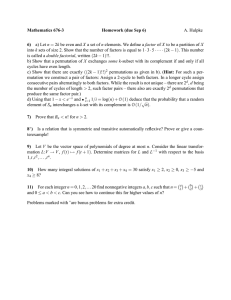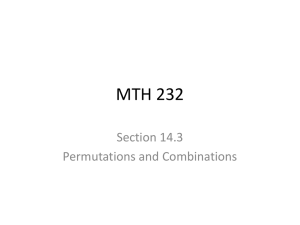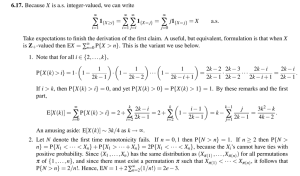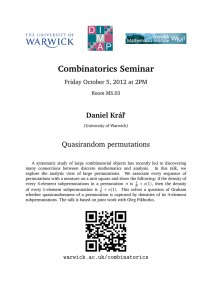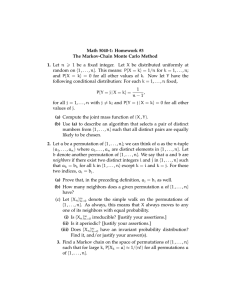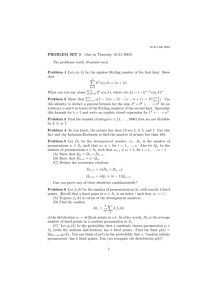Mathematics 366 Permutations A. Hulpke permutation
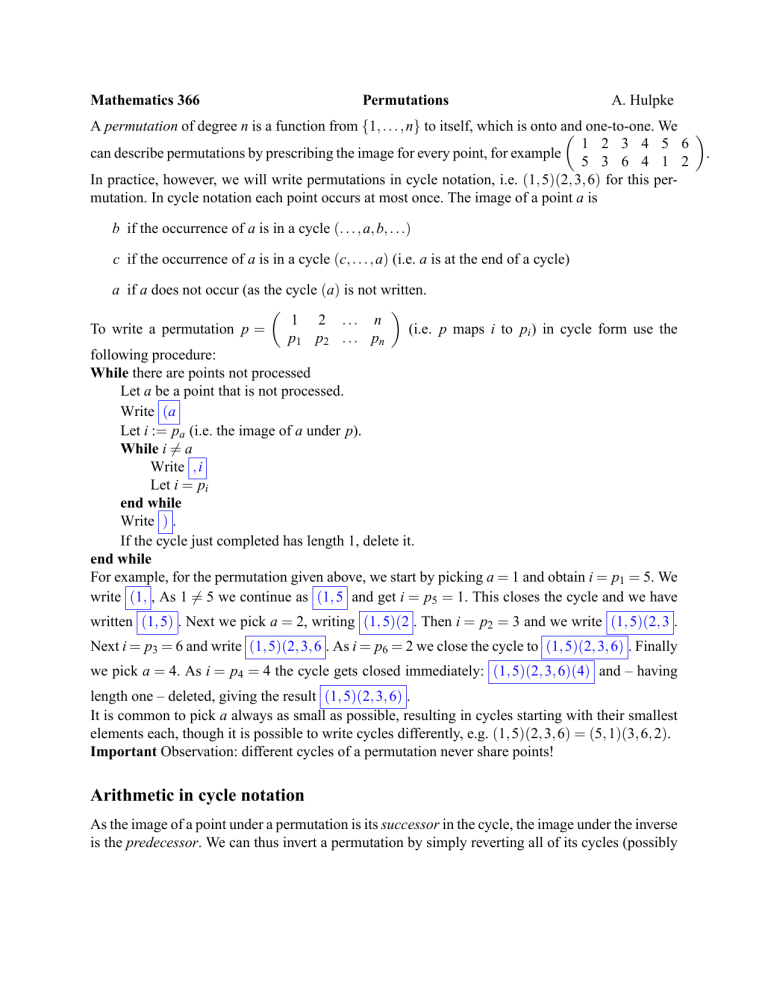
Mathematics 366 Permutations A. Hulpke
A permutation of degree n is a function from { 1 , . . . , n } to itself, which is onto and one-to-one. We
1 2 3 4 5 6 can describe permutations by prescribing the image for every point, for example
5 3 6 4 1 2
In practice, however, we will write permutations in cycle notation, i.e.
( 1 , 5 )( 2 , 3 , 6 ) for this permutation. In cycle notation each point occurs at most once. The image of a point a is
.
b if the occurrence of a is in a cycle ( . . . , a , b , . . .
)
c if the occurrence of a is in a cycle ( c , . . . , a ) (i.e. a is at the end of a cycle)
a if a does not occur (as the cycle ( a ) is not written.
To write a permutation p =
1 2 . . .
n p
1 p
2
. . .
p n following procedure:
While there are points not processed
Let a be a point that is not processed.
(i.e. p maps i to p i
) in cycle form use the
Write ( a
Let i : = p a
(i.e. the image of a under p).
While i = a
Write , i
Let i = p i end while
Write ) .
If the cycle just completed has length 1, delete it.
end while
For example, for the permutation given above, we start by picking a = 1 and obtain i = p
1
= 5. We write ( 1 , , As 1 = 5 we continue as ( 1 , 5 and get i = p
5
= 1. This closes the cycle and we have written ( 1 , 5 ) . Next we pick a = 2, writing ( 1 , 5 )( 2 . Then i = p
2
= 3 and we write ( 1 , 5 )( 2 , 3 .
Next i = p
3
= 6 and write ( 1 , 5 )( 2 , 3 , 6 . As i = p
6
= 2 we close the cycle to ( 1 , 5 )( 2 , 3 , 6 ) . Finally we pick a = 4. As i = p
4
= 4 the cycle gets closed immediately: ( 1 , 5 )( 2 , 3 , 6 )( 4 ) and – having length one – deleted, giving the result ( 1 , 5 )( 2 , 3 , 6 ) .
It is common to pick a always as small as possible, resulting in cycles starting with their smallest elements each, though it is possible to write cycles differently, e.g.
( 1 , 5 )( 2 , 3 , 6 ) = ( 5 , 1 )( 3 , 6 , 2 ) .
Important Observation: different cycles of a permutation never share points!
Arithmetic in cycle notation
As the image of a point under a permutation is its successor in the cycle, the image under the inverse is the predecessor. We can thus invert a permutation by simply reverting all of its cycles (possibly
rotating each cycle afterwards to move the smallest point first): ( 1 , 5 )( 2 , 3 , 6 )
− 1
( 1 , 5 )( 2 , 6 , 3 ) , ( 1 , 2 , 3 , 4 , 5 )
− 1
= ( 5 , 4 , 3 , 2 , 1 ) = ( 1 , 5 , 4 , 3 , 2 ) .
= ( 5 , 1 )( 6 , 3 , 2 ) =
To multiply permutations, trace through the images of points, and build a new permutation from the images, as when translating into cycle structure. For example, suppose we want to multiply
( 1 , 5 )( 2 , 3 , 6 ) · ( 1 , 6 , 4 )( 3 , 5 ) . The image of 1 is 5 under the first, and the image of 5 is 3 under the second permutation. Tus the result will start ( 1 , 3 . . .
. 3 maps to 6 and 6 to 4, thus ( 1 , 3 , 4 . . .
. 4 is fixed first and then maps to 1. So the first cycle of the result is ( 1 , 3 , 4 ) . We pick a next point 2. 2 is mapped to 3 and 3 to 5, so we have ( 1 , 3 , 4 )( 2 , 5 . . .
. 5 is mapped to 1 and 1 to 6 and (as there are no points left) we are done: ( 1 , 5 )( 2 , 3 , 6 ) · ( 1 , 6 , 4 )( 3 , 5 ) = ( 1 , 3 , 4 )( 2 , 5 , 6 ) .
Permutations in GAP
In GAP we can write permutations in cycle form and multiply (or invert them). The multiplication order is the same as used in class (again, remember that the book uses a reversed order): gap> (1,2,3)*(2,3);
(1,3) gap> (2,3)*(1,2,3);
(1,2) gap> a:=(1,2,3,4)(6,5,7);
(1,2,3,4)(5,7,6) gap> a^2;
(1,3)(2,4)(5,6,7) gap> a^-1;
(1,4,3,2)(5,6,7) gap> b:=(1,3,5,7)(2,6,8);
(1,3,5,7)(2,6,8) gap> a*b;
(1,6,7,8,2,5)(3,4) gap> a*b*a^-1;
(1,7,8)(2,6,5,4)
